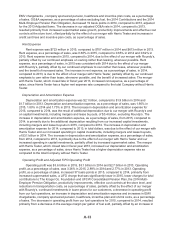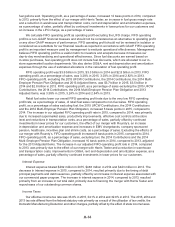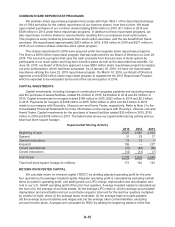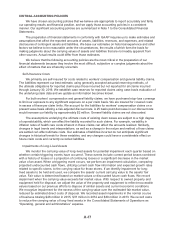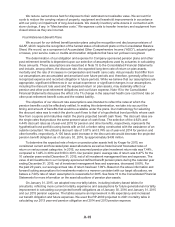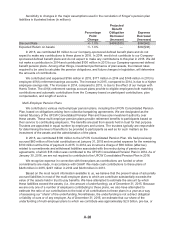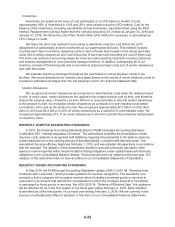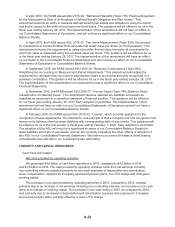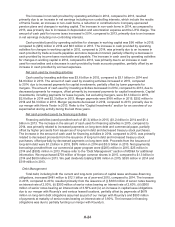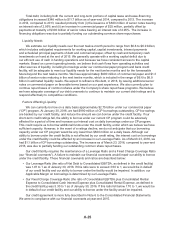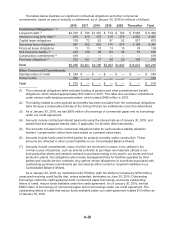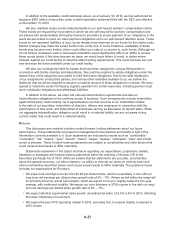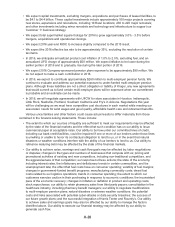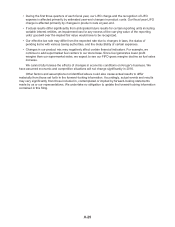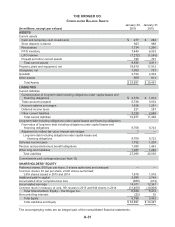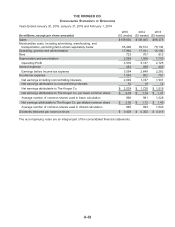Kroger 2015 Annual Report Download - page 96
Download and view the complete annual report
Please find page 96 of the 2015 Kroger annual report below. You can navigate through the pages in the report by either clicking on the pages listed below, or by using the keyword search tool below to find specific information within the annual report.A-22
Inventories
Inventories are stated at the lower of cost (principally on a LIFO basis) or market. In total,
approximately 95% of inventories in 2015 and 2014 were valued using the LIFO method. Cost for the
balance of the inventories, including substantially all fuel inventories, was determined using the FIFO
method. Replacement cost was higher than the carrying amount by $1.3 billion at January 30, 2016 and
January 31, 2015. We follow the Link-Chain, Dollar-Value LIFO method for purposes of calculating our
LIFO charge or credit.
We follow the item-cost method of accounting to determine inventory cost before the LIFO
adjustment for substantially all store inventories at our supermarket divisions. This method involves
counting each item in inventory, assigning costs to each of these items based on the actual purchase
costs (net of vendor allowances and cash discounts) of each item and recording the cost of items sold.
The item-cost method of accounting allows for more accurate reporting of periodic inventory balances
and enables management to more precisely manage inventory. In addition, substantially all of our
inventory consists of finished goods and is recorded at actual purchase costs (net of vendor allowances
and cash discounts).
We evaluate inventory shortages throughout the year based on actual physical counts in our
facilities. We record allowances for inventory shortages based on the results of recent physical counts to
provide for estimated shortages from the last physical count to the financial statement date.
Vendor Allowances
We recognize all vendor allowances as a reduction in merchandise costs when the related product
is sold. In most cases, vendor allowances are applied to the related product cost by item, and therefore
reduce the carrying value of inventory by item. When it is not practicable to allocate vendor allowances
to the product by item, we recognize vendor allowances as a reduction in merchandise costs based
on inventory turns and as the product is sold. We recognized approximately $7.3 billion in 2015, $6.9
billion in 2014 and $6.2 billion in 2013 of vendor allowances as a reduction in merchandise costs. We
recognized approximately 91% of all vendor allowances in the item cost with the remainder being based
on inventory turns.
RECENTLY ADOPTED ACCOUNTING STANDARDS
In 2015, the Financial Accounting Standards Board (“FASB”) amended Accounting Standards
Codification 835, “Interest-Imputation of Interest.” The amendment simplifies the presentation of debt
issuance costs related to a recognized debt liability by requiring it be presented in the balance sheet as
a direct deduction from the carrying amount of that debt liability, consistent with debt discounts. This
amendment became effective beginning February 1, 2015, and was adopted retrospectively in accordance
with the standard. The adoption of this amendment resulted in amounts previously reported in other
assets to now be reported within long-term debt including obligations under capital leases and financing
obligations in the Consolidated Balance Sheets. These amounts were not material to the prior year. The
adoption of this amendment did not have an effect on our Consolidated Statements of Operations.
RECENTLY ISSUED ACCOUNTING STANDARDS
In May 2014, the FASB issued Accounting Standards Update (“ASU”) 2014-09, “Revenue from
Contracts with Customers,” which provides guidance for revenue recognition. The standard’s core
principle is that a company will recognize revenue when it transfers promised goods or services to
customers in an amount that reflects the consideration to which the company expects to be entitled
in exchange for those goods or services. Per ASU 2015-14, “Deferral of Effective Date,” this guidance
will be effective for us in the first quarter of our fiscal year ending February 2, 2019. Early adoption
is permitted as of the first quarter of our fiscal year ending February 3, 2018. We are currently in the
process of evaluating the effect of adoption of this ASU on our Consolidated Financial Statements.



